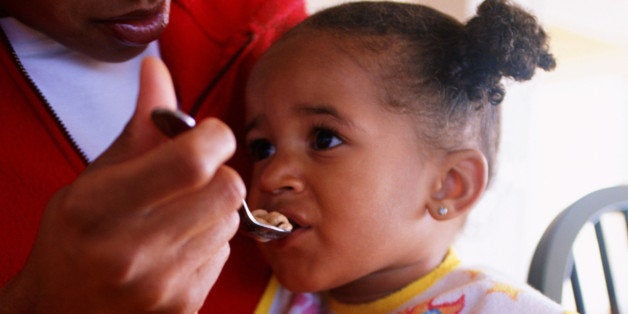
By Kathryn Doyle
(Reuters Health) - In the U.S., commercial foods for toddlers often have high amounts of sodium or added sugars, a new study shows.
For younger babies, most commercial foods were low in sodium and the majority of infant meals, vegetables, fruits, and dry infant cereals did not contain added sugars, which is good news, said lead researcher Mary E. Cogswell of the Centers for Disease Control and Prevention in Atlanta.
But the situation was more troubling for toddler foods.
"It was surprising that more than seven of 10 packaged toddler meals contained too much sodium," Cogswell told Reuters Health by email.
Also, she said, "a substantial proportion of toddler foods and infant and toddler snacks, even those we don't think of as sweet - like toddler meals and salty snacks - contained at least one added sugar."
"A healthy diet for the entire family, one that is limited in added salt and sugar and rich in fruits and vegetables, can help set taste preferences of the youngest family members eating from the table and ultimately prevent chronic diseases related to poor food choices," Cogswell said.
Recommended daily sodium intake ranges from 120 milligrams (mg) for infants 0 to 6 months, to 370 mg for ages 7 to 12 months and 1,000 mg ages 1 to 3 years, Cogswell said.
Using a 2012 database of more than 1,000 packaged infant and toddler foods and drinks sold in the U.S., the researchers found that almost all of the more than 600 vegetables, dinners, dry cereals and ready to serve grains and fruit geared to infants under age 1 were low sodium, and none were high sodium.
But nearly three-quarters of toddler dinners geared to kids age 1 to 3 were high sodium, meaning they contained more than 210 mg of sodium per serving, according to results in Pediatrics.
The researchers also flagged foods with more than 35 percent of their total calories from sugar, or at least one source of added sugars, like corn syrup, high- fructose corn syrup, honey and fructose.
Most infant vegetables, dinners, fruits and cereals did not contain added sugars. But half of the ready-to-serve mixed grains and fruits had at least one added sugar source, and often more than 35 percent of total calories came from sugar.
For toddlers, most savory snacks, desserts and juices or drinks contained at least one added sugar, and 61 percent of dairy-based desserts contained at least 1 added sugar and 35 percent of calories from sugar, the authors write.
"Regretfully, parents need to read labels carefully to avoid added salt and sugars in food commercially prepared for toddlers," said Dr. Susan S. Baker of the Digestive Diseases and Nutrition Center at the University at Buffalo in New York, in email to Reuters Health. Baker coauthored an editorial published with the report.
The most common added sugars were fruit juice concentrate, sugar, cane, syrup and malt.
Studies have found similar results in Canada and the UK, Cogswell said.
"When you buy processed or packaged foods, read the nutrition panel and look for those labeled 'low-sodium' or 'no salt' or 'no sugar added,'" Cogswell advises.
"An easy tip for parents is to focus on the amount of sodium per serving," she added. "Those foods with less than 140 mg per serving are considered low in sodium."
SOURCE: http://bit.ly/1BPkvPG Pediatrics, online February 2, 2015.

